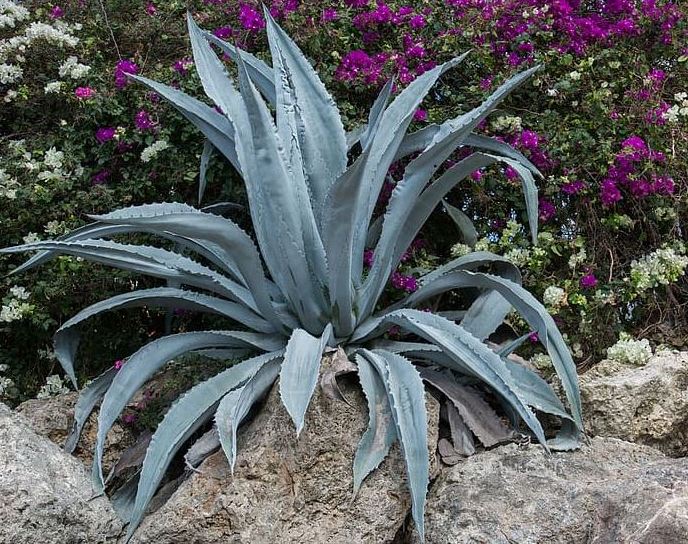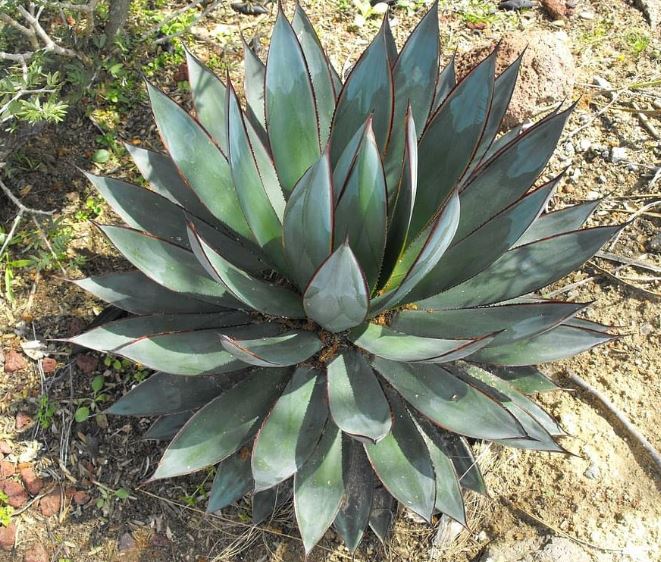What is Agave?
Agave is the common name and genus of a succulent plant in the flowering plant family Asparagaceae.
Agaves are native to tropical America that have tall flower stalks rising from a massive, often armed, rosette of thick fleshy leaves.
Most of the Agaves are monocarpic, meaning they die after they bloom.
There are over 200 species that can be grown in a variety of climate zones.
The Agave Americana and Blue Agave are the primary sources of agave nectar. Some varieties of Agaves are made into the alcoholic beverages mescal and tequila.
Additionally, many species are grown as ornamentals in desert landscaping.
It is a common misconception that agaves are cacti or aloes.
Agave plants take up to 7-10 years to mature before being harvested.

This site contains affiliate links to products. We may receive a commission for purchases made through these links. The price you pay is exactly the same if you do or do not use my links. There are no extras costs to you.
Agave Plant
Agave plants are native to arid and semiarid regions. They need little attention to thrive.
They do best in desert climates and zones with mild winters.
Agaves love full sun. Some varieties do well in partial shade too.
They prefer rocky or sandy soil, but they can tolerate any well-drained soil.
Water needs are moderate to light depending upon the heat of the season, but the plants should be allowed to dry out before irrigation.
Water the plant every 4-5 days until they are established. Over-watering will clog their roots and lead to root rot.
Mature agave plants are very drought tolerant.
In containers, watering once a week is sufficient as they prefer to dry out between watering.
There are tropical varieties like Agave Parryi Truncata that can take more water, but you should keep it dry.

Agave Nectar
Agave nectar is a syrup made by boiling the sap or juice extracted from the Agave salmiana or Blue agave plant. A popular distilled alcoholic beverage, Tequila is made from the fermentation of the sugars found in this plant.
Agave nectar is a natural sweetener, is an alternative to sugar and artificial sweeteners.
Agave plants naturally contain nutrients that could be good for health. But, most of the nutrients are lost due to the refining process.
The reason why agave nectar has become popular is due to its low glycemic index, which benefits diabetes.
Though agave nectar is low on the glycemic index is it is high on fructose. Excessive consumption of fructose can be toxic to the liver, can increase cholesterol levels, may cause bloating and flatulence.
Maguey sap obtained from the Maguey plant (Agave salmiana) has fewer fructose percentages.
Agave syrup color is darker if it is less filtered. The light color agave syrup is more filtered.
Agave Tequila

Agave tequilana, which is also is known as tequila agave or Weber’s blue agave, is the fast-growing agave that grows around 5 feet tall and 6 feet wide and has slender pointed blue-gray leaves that are striking in silhouette.
The base ingredient of the distilled spirit called Tequila is obtained from this plant.
Almost all Tequila production happens in Jalisco, Mexico. In Jalisco, this plant is grown in well-drained soils at moderate altitudes of 4,500 feet or higher.
It is a good landscaping plant for gardeners in high altitudes.
Although about 125 species of agaves are found in Mexico, only Weber’s blue agave can be used to make Tequila.
Agave tequilana needs full sun and can be grown where the temperature does not drop below 25 degrees Fahrenheit.
It needs very little irrigation and prefers well-drained soil.
Usually, it takes around ten years to bloom. It is difficult to predict when Agave tequilana blooms. This plant withers once it blooms.

Agave Americana
Agave Americana, which is also called the Century plant, originates from Southern USA and Mexico.
It is called a Century plant because it seems like it takes a century to bloom, although it blooms in 10 to 25 years.
It can grow up to 6 feet tall and up to 5 feet in width. Its leaves are gray-blue to blue-green with spines at the tips and on the margins.
It is cultivated worldwide as an ornamental plant. Its leaves are often curved above the middle, which is a distinctive feature of this species.
Not only does this plant look great in the landscape, but it is also a low-maintenance drought-tolerant plant.
They thrive will little care or no care at all.
This plant grows well in zones 9 to 11.
Century plant feels good in full sun or a lightly shaded place. It cannot survive freezing temperatures during the winter. If it is not getting enough sun, their leaves will curve downward.
They produce numerous offshoots before it dies, allowing for easy propagation. You can also propagate them from seeds.
Due to the jagged teeth along the edges and long leaves, the plant needs plenty of space. For some gardeners, this plant is undesirable because it tends to pup prolifically.
While century plant can be a beautiful addition to your landscape, It is best suited for conservatories, large hallways, and large buildings because of its size and sharp foliage.
Agave Americana is also called a Sentry plant, American aloe, or Blue Steel Agave.
There are several forms available, including variegated forms with attractive markings on the leaves.
You can also consider the Spineless century plant for smaller landscapes.
Buy Agave americana Sentry or Century Plant Maguey American Aloe jocad seeds on Amazon
Agave Blue Glow

Agave Blue Glow is a slow-growing evergreen succulent that that grows up to 2 feet tall and 3 feet wide.
This beautiful small agave, which produces elegant rosettes of painterly striations of green, blue, and gray are margined in red, is a hybrid of Agave attenuate and Agave Ocahui.
Agave Blue glow is not invasive as it is a slow-growing hybrid.
Although the edges of the leaves are not sharp, the tips are very sharp.
These hybrid agaves are especially attractive when planted in a spot where the sun can shine through the colorful leaves.
When grown outdoors, this plant usually matures between 10 to 15 years and produces beautiful greenish-yellow flowers. Agave Blue Glow is monocarpic, meaning it blooms once in its lifetime, and then it dies.
If kept indoors, these plants may never flower at all.
Agave blue glow is winter hardy in the hardiness zones 9 through 11.
It can grow successfully in part shade to full sun. It can tolerate little frost to some extent.
If grown in a container, choose a little bit larger container than foliage and make sure you place it in a bright, sunny window and water only minimally.
Although it is drought-tolerant, it needs regular watering in extreme heat. In winters, you can reduce watering significantly.
Propagation of this hybrid variety is not easy as this plant does not produce pups, and you cannot rely on the seeds to produce true offspring.



